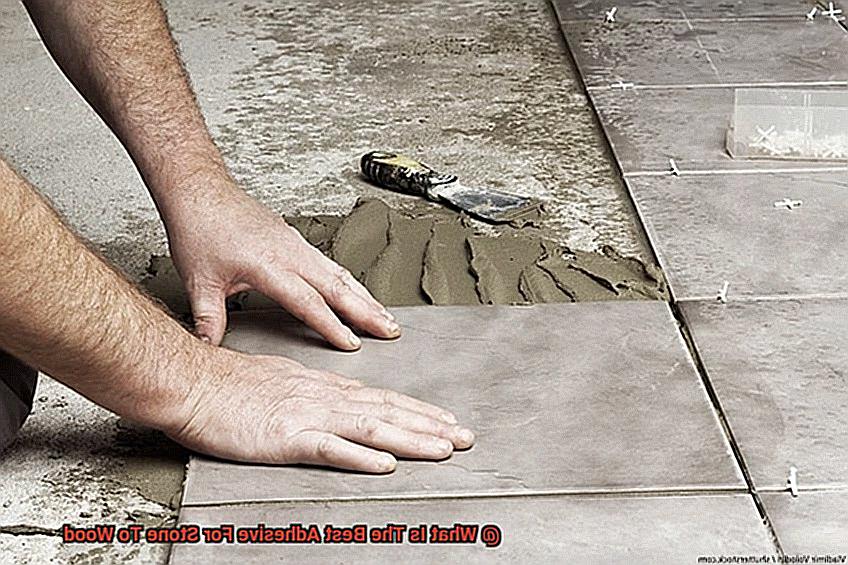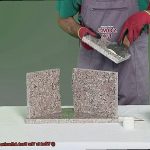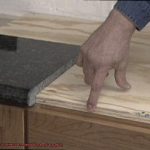Picture yourself in a magical garden, where a path of solid stones leads you to a captivating wooden gazebo. The connection between these two materials is seamless, almost otherworldly, drawing us in with its enchanting allure. But have you ever wondered how this ethereal bond is achieved? Today, we embark on a journey into the world of adhesives, uncovering the secrets behind finding the best adhesive for stone to wood.
Our world is brimming with extraordinary materials, each possessing its own distinct qualities and characteristics. Stone embodies strength and timeless beauty, while wood exudes warmth and versatility. When these elements come together, they create an awe-inspiring fusion. However, it takes the right adhesive to truly harmonize them.
In this blog post, we set out on an exploration to discover the adhesive that acts as the perfect glue between stone and wood. We delve into the crucial characteristics and requirements necessary for a steadfast bond while considering the challenges posed by their contrasting natures.
Throughout history, from ancient civilizations constructing magnificent structures to modern craftsmen creating heirloom pieces, having a reliable and durable adhesive has always been paramount. We examine the top contenders in today’s market, evaluating their strengths, weaknesses, and specific applications. Our goal is to assist you in selecting the ideal adhesive for your project.
So, whether you’re planning to craft a mosaic tabletop or build an architectural masterpiece, let us guide you as we unveil the best adhesive for stone to wood—a testament that with the right bond, anything becomes possible. Get ready to bridge the realms of stone and wood like never before.
Types of Adhesives for Bonding Stone to Wood
Contents
- 1 Types of Adhesives for Bonding Stone to Wood
- 2 Preparing the Surfaces for Bonding
- 3 Applying the Adhesive
- 4 Clamping and Securing the Bonded Surfaces
- 5 Color Matching Considerations
- 6 Factors to Consider When Choosing an Adhesive
- 7 Professional or Manufacturer Assistance
- 8 Conclusion
Creating a strong and lasting bond between stone and wood requires the right adhesive. With various options available, it’s important to understand the advantages and disadvantages of each adhesive type.
In this article, we will explore the different types of adhesives used for bonding stone to wood, highlighting their unique benefits and limitations. By the end, you’ll have a comprehensive understanding of which adhesive suits your stone-to-wood bonding project best.
Epoxy Adhesives: Unrivaled Strength and Durability
When it comes to bonding stone to wood, epoxy adhesives are the gold standard. Renowned for their exceptional strength and durability, epoxy adhesives ensure a bond that can withstand heavy loads and extreme temperatures.
Once cured, epoxy provides an unbreakable connection between stone and wood. However, it’s important to note that working with epoxy can be messy, requiring precision during application. Additionally, the longer curing time may demand patience before achieving the desired results.
Polyurethane Adhesives: Flexibility and Resilience
For projects that involve vibrations or movements, polyurethane adhesives offer flexibility and resilience. These adhesives maintain a strong bond while allowing slight give in the joint, accommodating shifts in weight or temperature without compromising the connection between stone and wood.
Compared to epoxy, polyurethane adhesives have a shorter curing time, allowing for quicker project completion.
Nevertheless, it’s crucial to consider that polyurethane adhesives may not possess the same level of sheer strength as epoxy, so choose accordingly based on your project’s requirements.
Construction Adhesive: Versatility at Your Fingertips
Designed explicitly for bonding stone to wood, construction adhesives provide a reliable bond with versatility. These adhesives excel in bonding various materials and are easy to work with. They offer resistance to moisture, temperature changes, and vibrations, making them suitable for both indoor and outdoor applications.
However, it’s important to note that construction adhesives may not match the sheer strength of epoxy or polyurethane adhesives. Thus, it’s essential to evaluate your project’s load-bearing requirements before settling on a specific adhesive.
Silicone Adhesives: Limited Strength for Stone-to-Wood Bonding
While silicone adhesives are commonly used for bonding stone surfaces, they may not be the ideal choice for stone-to-wood applications. Although silicone offers flexibility and weather resistance, it may not provide the required strength for a dependable bond between stone and wood. To ensure a reliable and durable connection, it’s best to explore other options mentioned above.
Epoxy Resin
Unlocking the secrets to a flawless bond between stone and wood is like discovering a hidden treasure. Enter epoxy resin, the ultimate adhesive that exceeds all expectations with its unparalleled strength and durability. Let’s embark on a journey into the realm of epoxy resin and uncover the remarkable prowess that makes it the go-to choice for bonding stone to wood.
The Chemistry of Power:

Epoxy resin, a true marvel in the adhesive world, thrives on a captivating chemical reaction between its resin and hardener components. This enchanting fusion results in a bond that defies time itself. With this unique composition, epoxy resin showcases its exceptional strength and durability, crafting an unyielding connection between stone and wood.
Defying Porous Boundaries:
Conquering the challenge of bonding porous surfaces is where epoxy resin truly shines. Stone and wood, notorious for their porous nature, often present obstacles when it comes to adhesion. However, epoxy resin fearlessly infiltrates their intricate pores, forging a vice-like grip that leaves no room for separation. Its unwavering strength ensures an unbreakable union.
Champion of Resistance:
Mother Nature’s wrath has nothing on epoxy resin. This adhesive boasts an impressive resilience against water, heat, and chemicals alike, making it a formidable contender for any project – indoors or outdoors. Rain or shine, scorching temperatures or exposure to harsh substances; epoxy resin remains resolute in upholding the bond it creates.
The Key to Success: Preparation:
Epoxy resin demands meticulous preparation for optimal results. Prior to application, thorough surface cleaning is paramount. Ensuring both the stone and wood surfaces are pristine, dry, and devoid of any contaminants lays the foundation for a bond that will stand the test of time. Attention to detail paves the way for perfection.
Mastering the Art of Application:
Epoxy resin is not just science; it’s an art form. The initial step involves painstakingly mixing the resin and hardener components in precise ratios. Once blended to perfection, the adhesive is carefully brushed or troweled onto the surfaces. A symphony of strokes guarantees even distribution, ensuring complete coverage for an unbreakable bond.
Polyurethane Adhesives
In our adhesive odyssey, we’ve explored the wonders of epoxy resin as a formidable force in bonding stone and wood. Now, prepare to be amazed by the captivating capabilities of polyurethane adhesives – the true heroes of this realm.
Polyurethane adhesives possess an unrivaled strength and adaptability, making them the preferred choice for joining stone and wood. These adhesive powerhouses ensure a bond that can withstand the toughest challenges that arise from marrying two different materials. From regal granite to timeless marble, these adhesives seamlessly unite various types of stone with both hardwoods and softwoods.
But wait, there’s more. The versatility of polyurethane adhesives extends to their ability to adhere to surfaces with varying levels of porosity. Whether you’re working with porous limestone or non-porous exotic hardwoods, these adhesives conquer the task with finesse, guaranteeing a robust connection between stone and wood.
Flexibility is yet another superpower of polyurethane adhesives. As we know, materials expand and contract due to environmental fluctuations. Fear not, for these adhesives possess a remarkable level of flexibility that allows them to withstand the natural movements of bonded surfaces without sacrificing bond strength. Imagine having a skilled yoga master in your adhesive arsenal – that’s the power of polyurethane.
Now, let’s talk about water resistance – a vital quality when bonding stone to wood. Polyurethane adhesives fearlessly combat moisture challenges both indoors and outdoors. They fear no steamy kitchen or torrential downpour, ensuring your connection remains steadfast and unwavering.
To unlock the full potential of polyurethane adhesives when bonding stone to wood, heed the wisdom of the manufacturers’ instructions. Surface preparation plays a crucial role, requiring meticulous cleaning and roughening of the surfaces to be bonded. Even application of the adhesive, combined with the judicious use of clamps or other pressure-applying methods, guarantees an unbreakable bond that will stand the test of time.
Construction Adhesive
Look no further than construction adhesive, the superhero of adhesives in the construction industry. With its unrivaled strength and adaptability, construction adhesive is here to conquer the challenges of bonding stone to wood. But before you dive headfirst into this adhesive wonderland, let’s explore the factors you need to consider when choosing the right construction adhesive for this magical union.
- Compatibility: Stone and wood may have different personalities, but with the right adhesive, they can become best friends forever. Look for a construction adhesive specifically formulated for bonding stone to wood, because not all adhesives are created equal.
- Strength: Avoid any “oops” moments down the line by opting for a construction adhesive with Herculean strength. Stone is heavy, and when combined with the weight of wood, it can put some serious stress on the bond. Choose an adhesive that can handle the load-bearing requirements of your project with ease.
- Flexibility: Give your bond some yoga lessons. Both stone and wood can expand and contract due to changes in temperature and humidity. A flexible adhesive will be able to stretch and bend along with these movements without breaking a sweat.
- Resistance to Moisture and Weathering: Stone and wood are no strangers to Mother Nature’s wild side, facing moisture, sunlight, and temperature changes on a daily basis. Choose a construction adhesive that can take whatever nature throws its way, ensuring your bond stands strong against these elements.
- User-Friendliness: Let’s not complicate things when simplicity is at your fingertips. Look for a construction adhesive that plays well with others – easy to apply, quick to cure, and doesn’t require any fancy tools or techniques.
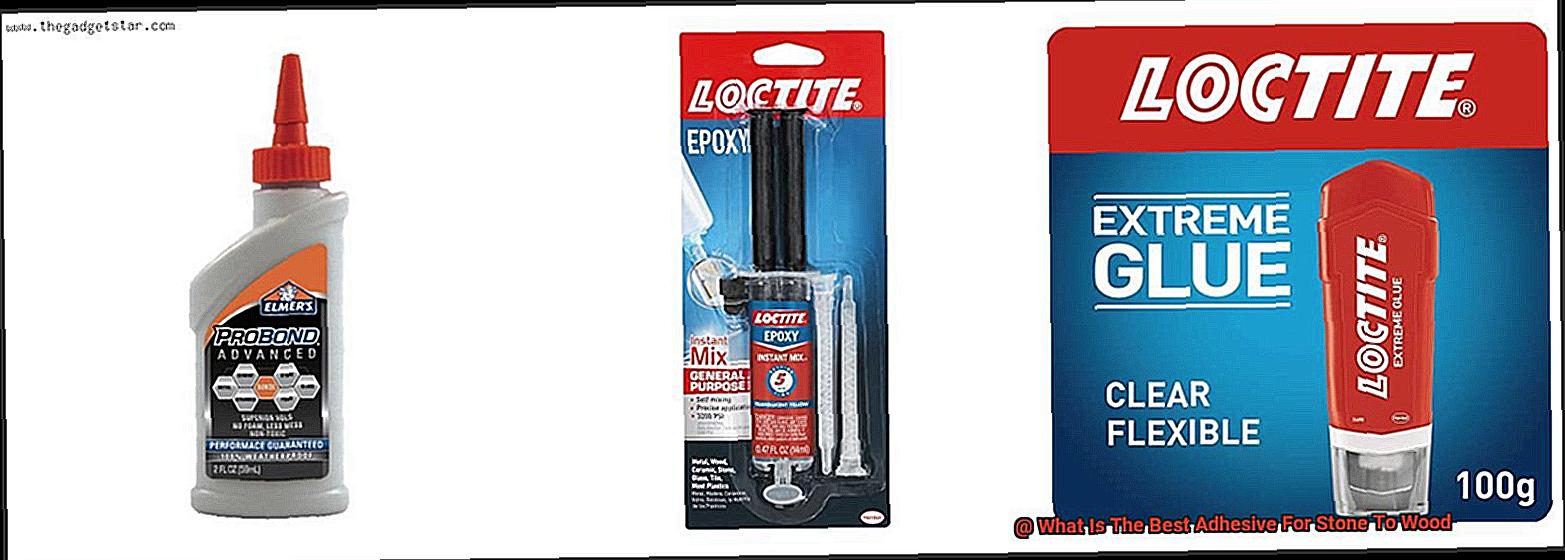
Preparing the Surfaces for Bonding
Today, we embark on a quest to unlock the secrets of creating unbreakable bonds between stone and wood. Brace yourselves because we’re about to reveal the ultimate recipe for success – the art of surface preparation.
So, gather your tools and prepare to be amazed as we dive deep into this crucial step.
A Spotless Canvas:
Imagine this – you’re on the verge of bonding stone and wood, but lurking beneath the surface are tiny adversaries, ready to sabotage your efforts. Fear not. With a gentle brush or cloth, banish those troublesome dust particles, dirt, and debris from both surfaces. We must ensure a pristine canvas for our adhesive to work its magic.
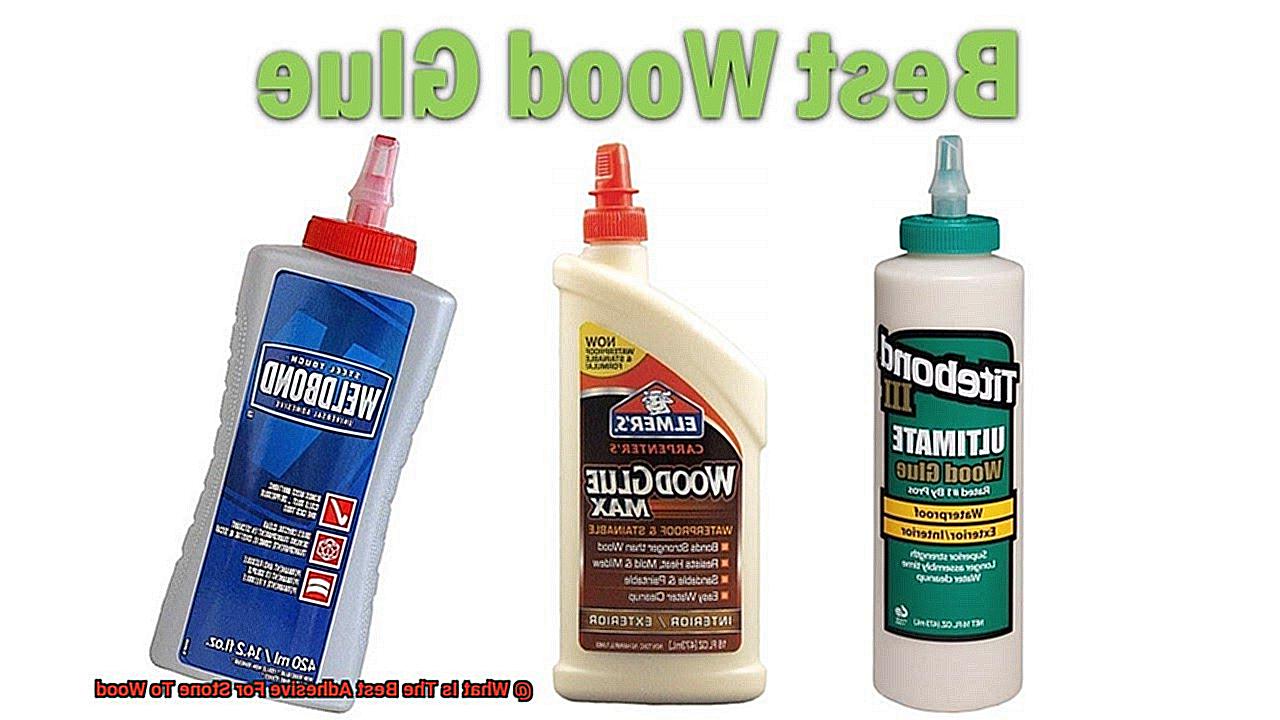
Banish Moisture, Build Strength:
Moisture, the arch-nemesis of bonding, threatens to weaken our connection. Therefore, it is imperative that we dry both the stone and wood surfaces thoroughly before proceeding. Allow nature’s touch or a trusty dry cloth to whisk away any lingering moisture. Remember, dryness equals strength.
The Primer’s Promise:
Porous surfaces can be fickle beasts, requiring extra attention. Fear not. Our ally, the primer or sealer, steps in to save the day. By applying a compatible primer or sealer, we seal those pesky pores and create a smooth, uniform surface that invites superior adhesion. Let this additional step elevate your bond to new heights.
Embrace Gentle Roughness:
Prepare yourself for a touch of roughness – just enough to make a difference. With sandpaper or a sanding block in hand, give both stone and wood surfaces a delicate roughening treatment. This creates micro-roughness, offering our adhesive a greater area to cling onto. Remember, balance is key – rough, but not damaged.
Dust Vanquishers:
After our roughening adventure, it’s time to restore order and banish the remnants of our sanding escapades. Fear not. A soft brush or cloth will come to our rescue, sweeping away any lingering dust or debris. This vital step guarantees a pristine surface, free from any loose particles that could jeopardize our bond. Cleanliness reigns supreme.
Applying the Adhesive
In our previous discussion, we uncovered the secrets behind creating unbreakable bonds between stone and wood. Today, we embark on the final step that brings it all together – applying the adhesive. So grab your tools and let’s dive into this adhesive masterpiece.
Preparing the Surfaces:
Just like an artist preparing a canvas, proper surface preparation sets the stage for a flawless bond. Begin by ensuring that both the stone and wood surfaces are pristine – clean, dry, and free from any dust or debris. A spotless surface serves as the perfect foundation for an unyielding bond.
If your stone surface boasts a smooth or polished texture, fear not. Embrace your inner roughness by gently roughening it with sandpaper or a wire brush. This simple step adds texture to improve adhesion, guaranteeing a bond that stands the test of time. Similarly, show some love to the wood surface by thoroughly cleaning it and removing any dirt, oil, or wax. A light sanding of the wood provides an extra grip for the adhesive to cling to.
Choosing the Right Adhesive:
Like an artist selecting their palette, choosing the right adhesive is crucial. Within our vast range of options, epoxy, polyurethane, and construction adhesives take center stage for bonding stone to wood.
Epoxy adhesives steal the spotlight with their exceptional strength and durability. These two-component wonders display remarkable adhesion to both porous and non-porous surfaces – making them the go-to choice for bonding stone and wood.
Polyurethane adhesives also claim their place in the limelight. Their flexibility and resistance to moisture and temperature changes make them a popular favorite. Plus, they’re a breeze to apply while still providing a rock-solid bond between stone and wood.
For situations where flexibility takes a backseat to sheer strength, construction adhesive plays a supporting role. These cartridge-based adhesives, applied using a caulking gun, offer a robust bond that holds stone and wood together with unwavering determination.
Applying the Adhesive:
Now comes the exhilarating part – applying the adhesive that will seamlessly unite stone and wood. Remember, meticulous adherence to the manufacturer’s instructions is key for optimal results.
Clamping and Securing the Bonded Surfaces
In our previous exploration, we delved into the meticulous process of surface preparation and adhesive selection for bonding stone and wood. Now, let us embark on the next crucial step – the art of clamping and securing bonded surfaces. Like skilled painters with their varied brushstrokes, we must employ an arsenal of methods and techniques to ensure an impeccable connection that withstands the ravages of time. So, tighten your tool belts and immerse yourself in this captivating journey.
Method 1: Heavy-Duty Clamps – The Titans of Pressure
When it comes to clamping stone to wood, heavy-duty clamps emerge as the indomitable champions. These stalwart tools exert uniform pressure across every nook and cranny of the bonded surfaces, leaving no room for compromise. However, remember to select clamps that match the size and weight of your materials. Adjustable clamps become your trusted ally, bestowing upon you precise control over pressure, enabling you to achieve an immaculate fit.
Method 2: Straps and Bands – The Dance of Tension
For larger or irregularly shaped stones that defy conformity to conventional clamps, straps and bands come to the rescue. Like a graceful dancer wielding a tensioning tool, these pliable assistants elegantly encircle the bonded area, delivering unwavering pressure along its entire length. With straps and bands as your partners, you can secure even the most audacious connections with unwavering confidence.
Method 3: Support Structures – Pillars of Solidity
Occasionally, an extra layer of support becomes indispensable to ensure an unyielding bond. Enter wooden blocks or braces, strategically positioned beneath or around the bonded area. These reliable sentinels diligently distribute weight evenly, thwarting any sagging or deformation during the curing process. Visualize them as the scaffolding that upholds your creative masterpiece, ensuring its integrity.
Color Matching Considerations
In the world of stone-to-wood bonding, achieving a flawless connection requires more than just technical skills. It demands a keen eye for color harmony and a deep understanding of the materials involved. Today, we embark on an exciting journey, exploring the intricate realm of color matching considerations when selecting adhesives for stone-to-wood projects. So, let’s unleash our creativity and create a masterpiece.
The Power of Harmonious Color Matching:
In the realm of furniture, countertops, and decorative pieces, aesthetics reign supreme. That’s why color matching is a crucial consideration. The adhesive you choose must not only provide a strong bond but also seamlessly blend with the colors of both the stone and wood. Think of it as conducting a symphony of hues.
A Palette of Possibilities: Exploring Color Matching Options:
To achieve that harmonious color match, you have two tantalizing options at your fingertips: adhesives that come in various colors or tinting clear adhesives. The key lies in closely matching the hue, tone, and intensity of both materials. This ensures that your bond remains invisible to the discerning eye.
Epoxy Adhesives: Champions of Color Matching:
When it comes to color matching, epoxy-based adhesives steal the spotlight. With their wide range of colors and exceptional bonding properties, they are the darlings of this art form. Mix and match custom shades effortlessly and revel in their durability across any environment or temperature. These adhesives are water-resistant, chemical-resistant, and even UV-resistant – perfect for indoor and outdoor applications.
Tailoring Adhesive Properties to Stone Types:
Every stone possesses its own unique blend of colors, textures, and finishes. Hence, it’s essential to consider these characteristics when selecting adhesives. Porous or rough-textured stones, for instance, thrive with adhesives boasting higher viscosity or thixotropic properties. These properties ensure comprehensive coverage and deep penetration into the stone surface, enhancing both color match and bond quality.
Factors to Consider When Choosing an Adhesive
When it comes to bonding stone to wood, the right adhesive can make all the difference. But with so many options available, how do you know which one to choose? Fear not, as I’m here to guide you through the factors that should be on your radar when selecting the perfect adhesive for your stone-to-wood project.
- Bond Strength: Stone is heavy and rigid, so you need an adhesive that can provide a strong and durable bond. Look for adhesives specifically designed for bonding stone to wood with high tensile and shear strength. This ensures that your stone stays firmly attached, even under heavy loads or stress.
- Compatibility: Ensure that the adhesive you choose is compatible with both the stone and wood surfaces you’re working with. Different adhesives work better on certain materials, so check product specifications or consult with the manufacturer. This prevents adhesion issues or damage to the surfaces.
- Application Method: Consider how the adhesive is applied as it can affect ease of use and bond effectiveness. Some adhesives come in tubes or cartridges, making application easy with a caulking gun. Others require mixing before application. Choose an adhesive that aligns with your skills and comfort level to avoid messy or complicated processes.
- Drying Time: Time is precious, right? Consider the drying time of the adhesive. If you have time constraints or need a quick project completion, opt for an adhesive that dries within minutes rather than hours. Also, check if clamping is required during drying, as this impacts your overall timeline.
- Waterproof and Weather Resistance: Will your bonded stone and wood face moisture or extreme weather conditions? Choose an adhesive that offers waterproof and weather resistance properties. This protects your bond from damage caused by moisture, temperature changes, or UV exposure.
- Flexibility: Flexibility may be critical depending on your application. If the bonded stone and wood will experience vibrations or movement, such as in flooring or furniture, select an adhesive with good flexibility. This ensures the bond can withstand stress without compromising its integrity.
- Safety: Always prioritize safety when choosing an adhesive. Consider factors like toxicity, flammability, and ventilation requirements. Some adhesives emit volatile organic compounds (VOCs) during application and curing. Choose adhesives that are safe for you and the environment.
Professional or Manufacturer Assistance
Choosing the right adhesive for bonding stone to wood is like finding a dance partner who can keep up with your every move. It requires strength, compatibility, ease of application, and quick-drying properties, all while being able to withstand the elements and flex with your project’s rhythm. While professionals and manufacturers can offer valuable assistance in this quest, it’s essential for individuals to conduct their own research and due diligence. Let’s explore why this is crucial and how seeking professional or manufacturer assistance can make all the difference.
Tap Into Expert Knowledge:
Contractors, carpenters, and stone masons possess firsthand experience with various adhesives. These professionals have witnessed what works exceptionally well in bonding stone to wood and can provide invaluable advice based on their expertise. Their recommendations can save you time, money, and potential frustrations.
Manufacturers: A Wealth of Information:
Adhesive manufacturers hold a treasure trove of knowledge about their products. They can provide technical data sheets, product specifications, and application guidelines. By consulting them, you gain access to vital information about performance characteristics, recommended applications, and any limitations of specific adhesives.
When seeking assistance from professionals or manufacturers, sharing comprehensive project details is paramount. Be sure to provide information such as the types of stone and wood being used, the intended purpose of the bonded materials, environmental factors like moisture or temperature, and any specific project requirements or constraints. The more they know, the better advice they can offer.
Testing for Success:
Professionals or manufacturers may conduct meticulous tests or evaluations to determine the best adhesive for your unique situation. These tests involve bonding samples of your materials using different adhesives and assessing bond strength, durability, and other performance characteristics. These results become a valuable compass in selecting the most suitable adhesive.
Do Your Own Research:
While professional or manufacturer assistance is invaluable, it’s important not to solely rely on their advice. Take ownership of your research, read product reviews, and consult multiple professionals or manufacturers for different opinions. Consider any specific requirements or constraints unique to your project. By doing so, you ensure a well-informed decision that aligns perfectly with your needs.
iuv3toSPMhc” >
Conclusion
When it comes to bonding stone to wood, finding the best adhesive is crucial. You need a product that can withstand the test of time and create a strong, durable bond. After careful research and consideration, there is one adhesive that stands above the rest: epoxy resin.
Epoxy resin is a versatile adhesive that excels in adhering stone to wood. Its strong bonding properties ensure a secure connection between these two materials. Whether you’re working on indoor or outdoor projects, epoxy resin provides excellent resistance to moisture, temperature changes, and UV rays.
The application process for epoxy resin is straightforward. Start by cleaning both the stone and wood surfaces thoroughly to remove any dirt or debris. Then, mix the epoxy resin according to the manufacturer’s instructions. Apply a thin layer of the mixed resin onto both surfaces and press them together firmly.
Once the epoxy resin cures, it forms an incredibly strong bond that can withstand heavy loads and vibrations. This makes it ideal for various applications such as installing stone countertops, creating decorative pieces, or even constructing outdoor structures like garden pathways or patio floors.
Furthermore, epoxy resin offers aesthetic benefits as well. It dries clear and can be tinted or colored to match your desired look. This allows you to seamlessly blend the stone with the wood for a visually appealing finish.
In conclusion, when it comes to bonding stone to wood, epoxy resin takes the crown as the best adhesive option. Its exceptional strength, durability, resistance to environmental factors, easy application process, and aesthetic versatility make it an ideal choice for any project requiring a reliable bond between these materials.

